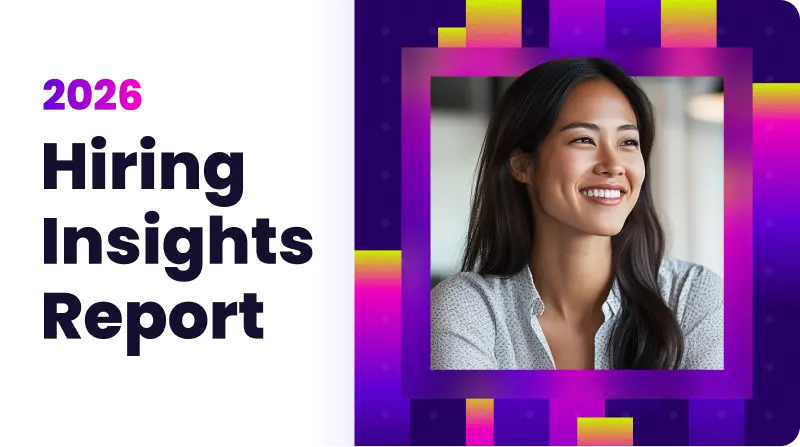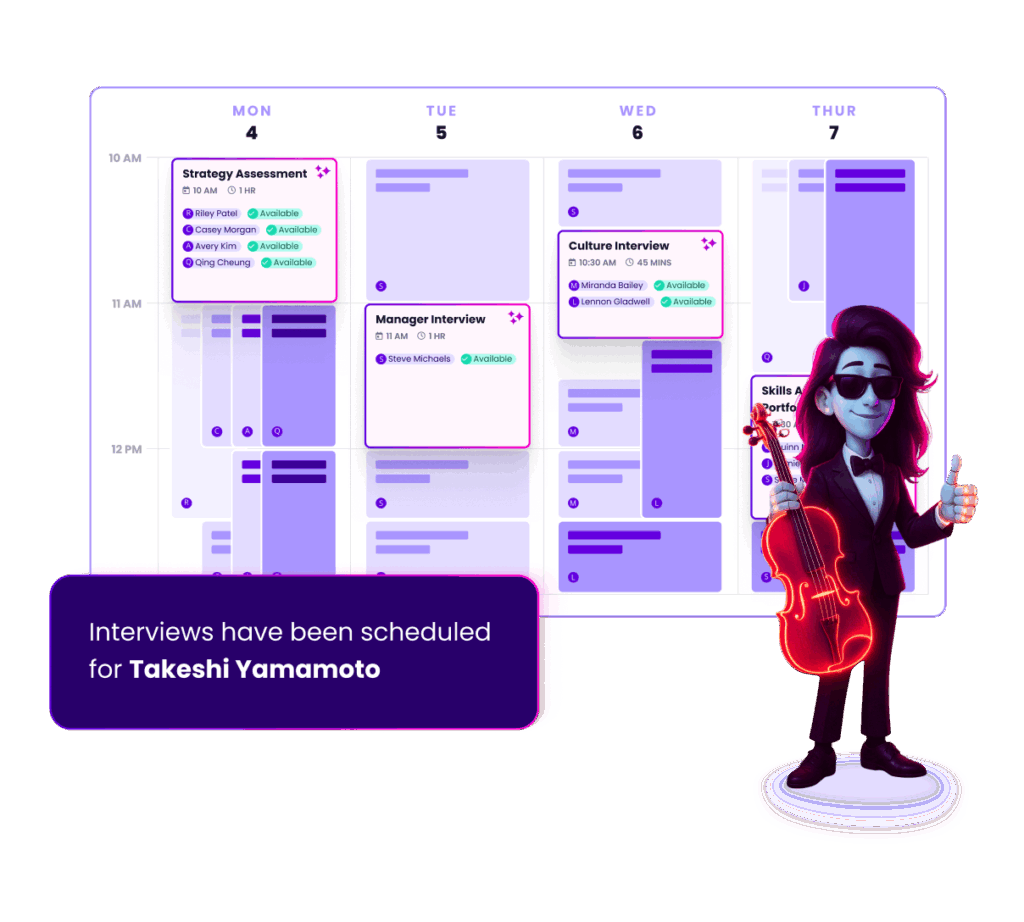Talent acquisition leaders today face intense pressure to do more with less – to fill roles faster, improve candidate quality, and elevate the hiring experience, all with leaner teams and tighter budgets. In this context, agentic AI has emerged as a game-changer that can transform how recruiting functions operate.
Unlike traditional automation or simple chatbots, AI agents behave like a virtual team member with the agency to act on your behalf. It’s already being applied in forward-thinking TA organizations to coordinate complex interview schedules, engage candidates 24/7, screen talent at scale, and much more.
This article explores what agentic AI really means in talent acquisition, how it’s driving real-world results today, and what emerging trends TA leaders should have on their radar.

Unlock 2026’s top hiring strategies: Insights from 500+ TA leaders
Be the first to uncover deep hiring insights specific to your sector — straight from the highest-performing TA teams.

The rise of AI agents in hiring
Adoption of AI in HR is accelerating rapidly. According to Gartner, 81% of HR leaders have explored or implemented AI solutions to improve processes. Why? Because the benefits are tangible.
HelloFresh, for example, saved 73% of their time spent scheduling using GoodTime’s AI-powered interview scheduling. And an HBR study found that companies using AI in hiring are 46% more likely to achieve successful hires (better quality of hire).
WATCH: How HelloFresh cut time-to-fill by more than two weeks with GoodTime
These aren’t just efficiency gains; they translate into strategic advantages in competing for talent. Agentic AI takes these benefits a step further by not only analyzing or recommending, but actually taking action in the recruiting process. Before diving into use cases, let’s clarify what agentic AI means in practical terms for talent acquisition.
What are AI agents in talent acquisition?
At the core, AI agents, or agentic AI, refer to AI systems that have the “agency” to autonomously execute tasks and make decisions within defined parameters to achieve goals. In other words, an AI agent doesn’t just provide insights or chat – it acts on your behalf. In talent acquisition, think of AI agents specialized in tasks like scheduling, scoring, sourcing, or candidate outreach that work collaboratively to drive the hiring process forward.
Each agent is oriented toward a specific function (for example, an interview scheduling agent or a candidate screening agent), and they can even communicate with one another in a connected ecosystem to deliver smarter outcomes.
An example of AI agents in action
To make this concrete, consider a typical scenario: coordinating a panel interview for a candidate. Traditionally, a coordinator would email back-and-forth with the candidate and multiple interviewers to find a suitable time, a process that can take days. An agentic AI scheduling assistant can handle this in minutes – it checks everyone’s calendars, proposes optimal slots, sends out invites, and even reschedules automatically if conflicts arise, all without human intervention. The AI isn’t just recommending times; it’s actually booking the meeting.
Another example: an AI sourcing agent could continuously scour databases or LinkedIn for candidates who match a role, then proactively reach out and pre-screen them, only alerting a recruiter when an interested, qualified candidate is ready to move forward. In essence, agentic AI behaves like a diligent, tireless team member that takes care of the heavy lifting in the background.
What AI agents mean for recruiting
This is a big shift from earlier recruiting AI tools that were mostly predictive (e.g. algorithms that rank resumes) or assistive (chatbots that answered FAQs but didn’t drive the process). Agentic AI is about ownership of tasks. It’s like a digital workforce. As GoodTime’s team describes it on a recent episode of the Transformation Realness podcast from Aptitude Research, “Think of it as AI agents – each specialized in tasks like scheduling, sourcing or internal mobility – working together and talking to each other to deliver smarter, more connected outcomes.”
Instead of siloed tools, you have an intelligent orchestra of agents coordinating across the talent lifecycle. The result is a recruiting function that operates with far greater speed, efficiency, and personalization – while your human team focuses on strategy and the personal touches that no machine can replace.
AI agents in action: Real-world use cases driving real results
Agentic AI may sound futuristic, but it’s already here, delivering value in real organizations. Let’s explore some of the most impactful use cases in talent acquisition today – and the outcomes TA leaders are seeing.
1. Automating complex interview coordination
One of the clearest wins for agentic AI in TA is automating interview scheduling and coordination – historically one of the most labor-intensive and chaotic parts of hiring. This is where GoodTime shines as a pioneering example. GoodTime’s platform uses human-centric AI to orchestrate the entire interview process with minimal manual effort. In fact, GoodTime customers are able to intelligently automate up to 90% of interview management tasks through AI, drastically reducing the back-and-forth emails and phone tags that bog down recruiting teams.
Upgrade your hiring journey with AI
GoodTime’s AI agents orchestrate the entire hiring journey — screening, scheduling, messaging, and more — so talent teams hire faster with a better candidate experience.

How does it work in practice? GoodTime’s agents act like an expert recruiting coordinator that never sleeps. It finds optimal interview times across multiple calendars (handling single interviews, multi-round panels, all-day “super days”, across time zones – whatever your process requires) and schedules them in seconds. No matter how complex the scenario, the AI can juggle it. As GoodTime touts, their AI is powerful enough to find slots for even the trickiest multi-day and panel interviews that basic tools can’t handle.
GoodTime considers interviewer availability, time zone differences, and even rules you set (like ensuring a diverse interview panel or including a required hiring manager), then it sends calendar invites and confirms with candidates automatically.
Importantly, GoodTime’s approach is human-centric – meaning the AI is designed to make the experience better for all people involved, not to replace them. Candidates get a smooth, responsive scheduling experience (no waiting days for a follow-up), and recruiters and hiring managers get their time back. For instance, candidates can even self-schedule via a branded portal, pick a convenient slot from the available options the AI agent identified. And if an interviewer cancels last-minute, GoodTime’s AI can automatically find a qualified replacement from your interviewer pool to keep the process on track.
The impact is profound: organizations using GoodTime have cut time-to-hire by as much as 50% thanks to faster coordination. Recruiters save countless hours of admin work – our Hiring Insights Report found that talent teams spend on average about one-third of their time on scheduling tasks when scheduling is done manually.
And GoodTime doesn’t stop at scheduling. It leverages agentic AI in other parts of interview logistics, too. For example, the platform provides intelligent interviewer selection, automatically recommending the most appropriate interviewers for a given role and ensuring every interviewer is prepared with the right context. It can automate routine communications, sending personalized SMS or WhatsApp messages to candidates for reminders and updates. GoodTime essentially orchestrates interviews from end to end, as CEO Ahryun Moon explains, “It’s an AI platform that manages the entire experience for every stakeholder – candidates, interviewers, recruiters, and hiring managers.”
By turning raw scheduling and feedback data into actionable insights and recommendations, GoodTime’s AI even advises TA teams on how to improve their process (for instance, suggesting ways to reduce bottlenecks or improve interviewer training).
The end result is a dramatically streamlined operation: enterprise TA teams have used GoodTime to shorten hiring timelines, halve their time-to-hire, and significantly reduce candidate drop-off, all while creating a more engaging experience for candidates and interviewers.
2. Enhancing candidate engagement and experience
Another arena where agentic AI is making waves is candidate engagement – ensuring applicants feel heard, informed, and valued throughout the process. In today’s competitive market, a poor candidate experience can kill your hiring results; top talent won’t wait around if communication lags. AI agents can dramatically improve this by serving as a 24/7 concierge for your candidates.
Consider AI-powered chatbots and texting assistants that many TA teams now deploy. These aren’t the clunky bots you might have played with years ago, but sophisticated conversational agents that can interact with candidates in natural language. They can answer candidates’ common questions instantly (about the role, next steps, company culture), guide them through application steps, and crucially, take action like scheduling interviews or collecting additional information.
For example, an AI assistant might reach out to a promising applicant minutes after they apply – via SMS or chat – to ask a few screening questions, then seamlessly schedule their initial interview on the recruiter’s calendar by the next day. By the time a human recruiter gets involved, the candidate is already engaged and moving forward. This kind of always-on engagement ensures no candidate falls through the cracks and nobody is left waiting in limbo.
Platforms like GoodTime can send automated, personalized messages over email, text, or WhatsApp to keep candidates warm. For instance, once an interview is scheduled, the candidate might automatically get a text: “Looking forward to your interview with Acme Corp on Tues at 10am! Here’s a prep guide. Let us know if you have any questions.” This level of attentiveness is usually impossible for busy teams to maintain manually, especially at scale.
The payoff is a significantly improved candidate experience, which has downstream benefits for your hiring success. Candidates feel respected and informed, which makes them more likely to stay in the process and accept offers.
Candidates themselves are increasingly comfortable with AI-driven interactions in early stages. A recent survey by Allegis found that 58% of job seekers are comfortable interacting with AI chatbots for routine questions and scheduling in the initial application process. In other words, a well-designed AI agent isn’t viewed as a turn-off – it’s often seen as a helpful guide.
And for TA leaders, improved candidate experience is not just a “nice-to-have” – it directly ties to your ability to hire quality talent. Agentic AI gives you the leverage to provide white-glove treatment to every candidate at scale. It’s the difference between a candidate feeling like they sent their resume into a black hole versus feeling like the company is enthusiastic and on-the-ball. And when 95% of recruiters believe AI can improve the application experience for candidates, it’s clear that leveraging these tools is fast becoming a best practice to stay competitive.
WATCH: How Canva used AI to accelerate and elevate the hiring experience at the same time
3. Intelligent screening and assessment for better quality hires
Upstream from interviews and engagement, agentic AI is also transforming how organizations screen and assess candidates, with a keen eye on improving the quality of hire. Traditional screening – manually sifting hundreds of resumes or conducting one-to-one phone screens – is not only time-consuming, it’s also prone to human bias and fatigue. AI offers a way to automate initial screening objectively and efficiently, surfacing the best candidates that might otherwise be overlooked.
Agentic AI in screening might take the form of an algorithm that evaluates resumes/applications against job requirements and ranks or shortlists candidates for recruiter review. Or it could be an AI that administers and scores preliminary assessments (like skill tests or even one-way video interviews). Crucially, an agentic system doesn’t just passively score – it can decide which candidates move forward to the next stage based on defined criteria, and trigger the next steps (e.g. invite a candidate to schedule an interview, or send a polite rejection email), all without waiting on a recruiter’s manual input.
Large enterprises have reported stunning results using AI-driven screening and assessment. Hilton’s talent acquisition team leveraged AI to evaluate candidates (likely through AI assessments and scoring) and reported that their hiring rate improved by 40% while the time to fill positions decreased by 90%.
That means not only were they hiring much faster, they were getting better hires out of it – a powerful one-two punch. This was achieved by letting AI handle the heavy lifting of identifying which candidates had the highest probability of success, so recruiters only spent time on the cream of the crop.
Of course, the human touch remains vital. The recruiter and hiring manager still make the final call and conduct the nuanced assessments of culture fit, etc. But by the time they engage, AI agents have done the groundwork – the pile of 500 resumes is now a curated list of 50 highly-qualified leads, plus rich insights on each. This blend of AI efficiency and human judgment leads to better hires overall. As one Harvard Business Review study put it, companies using AI in hiring see more successful hires and more diverse, high-performing teams as a result.
4. Data-driven decision-making and process optimization
Beyond direct hiring tasks, agentic AI can also function as an ever-vigilant analyst and advisor, monitoring your recruiting data and proactively suggesting improvements. Many talent acquisition leaders struggle with questions like: Where are our bottlenecks? What’s the best source of hire for a certain role? How can we improve our interviewer training or reduce bias? Traditionally, answering these requires manual data crunching or intuition. Now, AI agents can continuously analyze your pipelines and outcomes to surface actionable recommendations.
For example, GoodTime’s platform not only coordinates interviews, it also provides AI-driven insights and recommendations on your hiring process. It might detect that interviews for engineering roles are consistently taking too long to schedule and suggest adding more interviewers or adjusting calendar settings to fix the bottleneck. Or it may notice that one team’s candidates have a lower offer acceptance rate and prompt you to investigate or adjust your candidate experience for that team. These are like having a data-savvy consultant on staff who points out where you can tweak the system for better results.
From a strategic standpoint, TA leaders can leverage these AI-generated insights to continuously refine their approach. It transforms talent acquisition into a more agile, metrics-driven function, where improvements aren’t just yearly or quarterly – they’re happening in real-time, guided by an always-on intelligence. The end results include faster cycle times (with many companies seeing 30–50% reductions in time-to-fill through AI optimization, lower cost per hire, and higher stakeholder satisfaction.
Emerging trends: Toward a fully AI-assisted TA function
Agentic AI in talent acquisition is evolving fast. What we see in leading organizations today is likely just the beginning of an AI transformation in TA. As you consider the next 12–24 months, a few emerging trends stand out:
- Multi-Agent Ecosystems: Rather than single-point solutions, we’re moving toward interconnected AI agents across the hiring lifecycle. GoodTime’s partnership with Workday, for instance, hints at a future where a scheduling agent, a sourcing agent, and an internal mobility agent all talk to each other. In such an ecosystem, your ATS or HRIS becomes an intelligent hub where agents share information and coordinate action. Imagine an internal mobility AI agent identifying a great internal candidate, then pinging the scheduling agent to set up an interview, all automatically. This kind of seamless integration could dramatically improve efficiency and outcomes across HR functions.
- Natural Language Interfaces: AI is becoming more conversational and easier to direct. We’ll see recruiters and hiring managers interacting with AI agents through simple natural language – “AI, find and schedule interviews with five qualified data engineer candidates in the next two weeks” could be a single command that triggers a chain of AI-driven events. Part of GoodTime’s vision, for example, is to evolve into the ultimate scheduling agent that can engage with natural language to schedule even the most complex interviews. This means less time learning software and more just telling the AI what you need in plain English (or any language), and letting it figure out the rest.
- Generative AI for Personalization: The rise of GPT-4o and similar technologies is enabling AI to generate highly personalized communications and content. For TA, this trend will amplify agentic AI’s impact on candidate experience. We’re already seeing tools that auto-generate tailored outreach emails or craft personalized interview agendas. Soon, your AI assistant might create a custom interview kit for each candidate (based on their resume and the role) to help interviewers ask relevant questions – again, work that happens behind the scenes to make humans more effective. The key is these generative capabilities will be integrated into agent workflows, so the AI not only decides an email needs to be sent, it also writes a compelling version of it for you.
- AI Decision Support (Not Replacement): A persuasive message for senior TA leaders is that agentic AI is there to augment your team, not replace it. We expect emerging best practices to emphasize a “human-in-the-loop” approach for critical decisions. AI might autonomously schedule and screen, but when it comes to final interviews and offers, it provides recommendations and insights to empower human decision-makers. The trend is toward AI handling the drudgery and providing data-driven counsel, while recruiters make the empathetic, nuanced judgments. AI should make hiring more human, not less – by freeing up your people to focus on relationship-building, candidate coaching, and strategic planning.
In summary, the future of talent acquisition points to a model where AI agents function as an integrated digital workforce, collaborating with your human team. Those agents will get smarter, more connected, and more capable of complex decision-making as the technology advances. For TA leaders, that means now is the time to start embracing agentic AI – not as a shiny toy, but as a core strategy to transform your talent function.
Final thoughts: Gaining a competitive edge with AI agents for hiring
Agentic AI is no longer a theory or buzzword; it’s a practical toolkit that is delivering real results in talent acquisition today. From automating the grunt work of interview scheduling to engaging candidates in a personalized way, screening talent with greater accuracy, and continuously optimizing the hiring process, AI agents are helping recruiting teams achieve what was previously impossible. And they’re doing it at scale: global organizations like Unilever, Hilton, Vodafone, and many others have already proven that AI can save tens of thousands of hours and dramatically improve key metrics like time-to-fill, quality of hire, and candidate satisfaction.
For talent leaders in large enterprises, the message is clear: those who leverage agentic AI effectively will gain a competitive edge in attracting and hiring the best talent. When your recruiters have AI assistants coordinating interviews and screening candidates, they become exponentially more productive – able to focus on building relationships and strategic initiatives instead of chasing schedules and paperwork. When your candidates get fast, thoughtful engagement through AI, they are more likely to choose your offer over a slower-moving competitor’s. And when your hiring decisions are augmented by AI insights, you assemble higher-performing teams that drive business success.
Crucially, adopting agentic AI is about empowering your people, not sidelining them. It’s about letting machines do what they do best (speed, data-crunching, routine tasks) so that humans can do what we do best – connect, persuade, judge nuance, and create. As one TA leader put it, accept that AI will change our work, but see it as an enabler – a co-pilot – for the future of talent acquisition.
Now is the time for TA leaders to lean into agentic AI. The technology has matured, the use cases are proven, and the ROI can be immediate. Start with a high-impact area (like interview scheduling or candidate outreach) and let the wins accumulate. Engage your team in the change, highlight how it will elevate their roles, and ensure you maintain a human touch where it counts. With each successful AI-driven hire, you’ll be building momentum for a recruiting organization that is not just keeping up with the times, but actively defining the cutting edge of talent acquisition. In the war for talent, an AI-augmented team is a strategic advantage – one that forward-thinking leaders are already leveraging to pull ahead.




